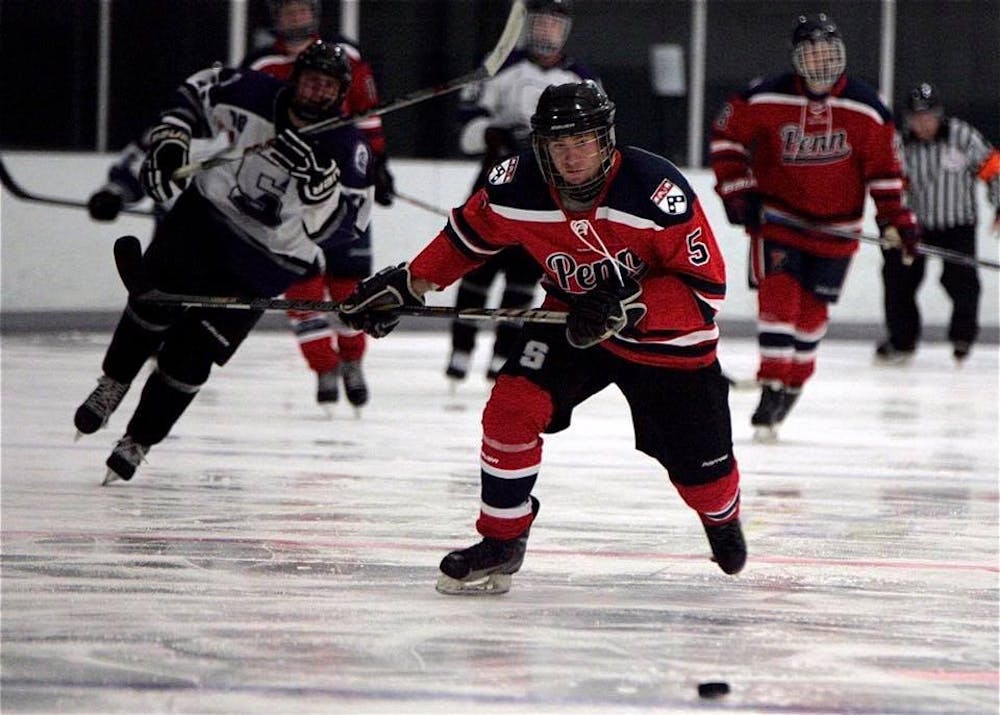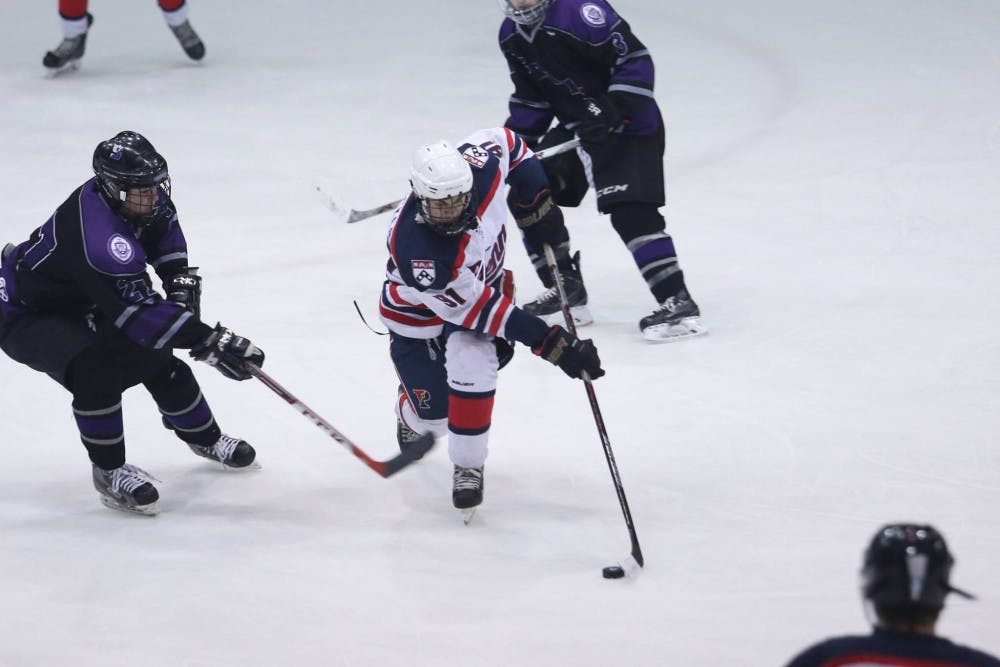
Photo from Penn Hockey
After 41 years, there may be light at the end of the tunnel.
On July 9, former Penn hockey president Rolando Bonachea and chairman of the Penn Hockey Alumni Board Stu Siegel announced the start of a university supported Penn Hockey Endowment in an email to the Penn hockey community. Bonachea and Siegel hope that the endowment will ultimately be able to fund both men’s and women’s Division I ice hockey teams at Penn — for the first time since 1977-78. They expect the process to take about 10 years until the programs regain D-I status.
While Penn Athletics supports the endowment as a fundraising effort for the club teams, it has not backed the proposal for a varsity program.
“Penn Athletics and Recreation is currently working with the ice hockey alumni community to create an endowment to support our program and student-athletes at its current club sport level. We continue to strive to provide our ice hockey student-athletes with a positive experience and are appreciative of the interest and enthusiasm of our alumni in this sport,” Kevin Bonner, Senior Associate Athletic Director for Governance and Administration, wrote in a statement.

Bonachea and Siegel said that after numerous conversations between Penn Athletic Director M. Grace Calhoun and Penn hockey representatives, it was made clear that the teams will need to prove there is sufficient financial sustainability and alumni support before the University backs the funding of two D-I hockey programs.
“We’ve made a lot of progress over the last three years in our fundraising. We’ve roughly doubled [our fundraising] in the past few years in order to be able to provide more resources for the teams and fund their operations,” Bonachea said. “[With this], we’re building incrementally to get us in a position where we’ll be able to show the University that we have the ability to raise large sums of money and also have a large level of participation from the community.”
Penn hockey says they can only make so much progress in this endeavor without full financial support from Penn Athletics. The current aspirations of this fundraising campaign is to raise enough funds to inspire the University to back the proposal and help raise the remaining necessary funds.
“In the end, it’s primarily going to come down to money. Will someone step up to the plate and make it happen? It’s a chicken and an egg thing, because I can’t go out and say, ‘If you make a $10 million or $20 million donation, [Penn] is going to have a varsity program,’ because it’s not my decision,” Siegel said. “I have never gotten the commitment from the Athletic Director, [Calhoun], saying, ‘All you have to do is raise this much money and you’ll have a varsity program.’ She’s never said that. I’ve asked her, and she keeps saying, ‘just keep doing the course, become more competitive, and we’ll put you on a path.’”

Despite the uncertainty of a potential move to varsity status, the leadership of Penn Hockey intends on using that eventual goal to inspire fundraising to make the current club team more self-sufficient.
The immediate goal of the endowment is to raise $50,000 of seed money by fiscal year 2020. To date, Penn Hockey alumni have donated about $20,000 of that $50,000 goal.
“Through the assistance of the Penn Fund, the Athletic Department, and the Penn Champions Club, the endowment has been created with the principal goal of supporting the operations and the expansion of the men’s and women’s ice hockey programs,” the Friends of Penn Hockey wrote in their public announcement of the endowment via email to the Penn hockey community. “Included in this goal is the intent of reestablishing the Varsity hockey programs in the future.”
Bonachea estimates that the total endowment will need to approach $50 million — 1000 times their 2020 fundraising goal — in order for the men’s and women’s teams to sustain themselves in perpetuity without having to rely on annual alumni donations at the varsity level. Many of Penn’s existing varsity teams still rely on alumni donations.
Last season, the combined operating costs for the men’s and women’s programs totaled about $120,000. According to figures supplied by Bonachea, about 45% of the funding came from the University, 35% by donors, and the remaining 20% through player dues. University funding for the programs has remained relatively constant over the past few seasons, contributing around $58,000 per season.
Currently, the men’s and women’s hockey programs at Penn operate as club sports in Division II of the American Collegiate Hockey Association (ACHA), competing against other regional teams within a two hour bus ride from campus.
“When people hear ‘club sport’ they think more of an intramural league. It’s hardly that at all. The reality is that most of collegiate hockey in the United States is actually club. There are actually only 61 varsity [men’s] Division I programs in the entire country and six of those are Ivy League teams,” Siegel said.

“If we were to raise $50,000 — at the University’s [endowment] spending rule [of 4.5%] — that would leave us with only about $2,200 to spend for the teams. That is enough to cover about three practices and a game worth of ice time,” Bonachea said. “It would cover a very small amount of our current 2020 fiscal year needs, but we think that the endowment might help unlock a path towards varsity hockey in the future.”
As described in Siegel and Bonachea’s plan, originally entitled ‘Vision 2025’, in order to reach D-I status, the Quakers will first have to file an application to play in the American Collegiate Hockey Association’s Division I, then move up to the NCAA ranks. Most teams begin in D-III before moving to D-I as an Independent before joining a conference. The six existing Ivy hockey programs play in the Eastern College Athletic Conference.
Penn hockey’s fundraising efforts coincide with the announcement in February that the Class of 1923 Ice Rink — Penn’s home rink — is slated for a $7 million renovation. The renovation is funded in large part by the Philadelphia Flyers Alumni and former Flyer’s owner Ed Snider’s youth hockey foundation. Penn contributed 600,000 dollars to the renovation, which the clubs claim would make the rink suitable for D-I play.
“We did just get some cooperation with the [Philadelphia] Flyers and the Snider organization, to renovate the arena,” Siegel said. “The money that the Snider organization is putting in really assures the future of [the stadium] and alleviates those financial needs. It’ll essentially be a D-I varsity facility when they’re done.”
With the creation of the endowment as a first step, Penn hockey will continue to build on the fund, striving toward University recognition of their long-term plan. Although there are many obstacles that the programs must confront, Bonachea and Siegel are hopeful that the new endowment can be the seed money for a return to the highest level of college hockey.
The Daily Pennsylvanian is an independent, student-run newspaper. Please consider making a donation to support the coverage that shapes the University. Your generosity ensures a future of strong journalism at Penn.
Donate



